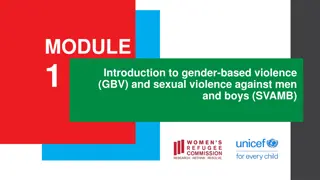Providing First-Line Support for Women Experiencing Violence
Learn how to effectively provide first-line support to women subjected to violence by listening attentively, inquiring sensitively, and validating their experiences. The key elements involve identifying needs and concerns, responding empathetically, and empowering survivors to seek help while respecting their autonomy. By demonstrating clinical skills and offering emotional support, healthcare providers can play a crucial role in assisting women in crisis.
Download Presentation

Please find below an Image/Link to download the presentation.
The content on the website is provided AS IS for your information and personal use only. It may not be sold, licensed, or shared on other websites without obtaining consent from the author. Download presentation by click this link. If you encounter any issues during the download, it is possible that the publisher has removed the file from their server.
E N D
Presentation Transcript
Session 6 First-line support using LIV(ES), part 1: Listen, Inquire, Validate Caring for women subjected to violence: A WHO curriculum for training health-care providers Session 6: First-line support using LIV(ES), part 1: Listen, Inquire, Validate 1
Learning objective Demonstrate clinical skills appropriate to one s profession and specialty to respond to VAW Competencies Know the content of first-line support (LIVES) Demonstrate skills in offering the first three elements of first-line support Listen, Inquire, Validate Caring for women subjected to violence: A WHO curriculum for training health-care providers Session 6: First-line support using LIV(ES), part 1: Listen, Inquire, Validate 2
What is first-line support? DO identify needs and concerns respond to emotional, physical, safety and support needs listen & validate experiences & concerns help her feel connected to others, calm and hopeful empower her to feel able to help herself and to seek help explore options respect her wishes DON T try to solve her problems try to convince her to leave a violent relationship try to convince her to go to the police or courts ask questions that force her to relive painful events ask her to analyse what happened or why pressure her to tell you her feelings & reactions Caring for women subjected to violence: A WHO curriculum for training health-care providers Session 6: First-line support using LIV(ES), part 1: Listen, Inquire, Validate 3
First-line support job aid Learn to listen with your Eyes undivided attention Ears Heart with caring and respect giving her your truly hearing her concerns Caring for women subjected to violence: A WHO curriculum for training health-care providers Session 6: First-line support using LIV(ES), part 1: Listen, Inquire, Validate 4
Listen Active listening dos and don ts Dos Don ts ? ? How you act Be patient and calm. Don t pressure her to tell her story. Let her know you are listening; for example, nod your head or say hmm Don t look at your watch or speak too rapidly. Don t answer the telephone, look at a computer or write. Your attitude Acknowledge how she is feeling Don t Judge what she has or has not done, or how she is feeling. Don t say: You shouldn t feel that way, or You should feel lucky you survived, or Poor you . What you say Give her the opportunity to say what she wants. Ask, How can we help you? Don t assume that you know what is best for her. Encourage her to keep talking if she wishes. Ask, Would you like to tell me more? Don t interrupt. Wait until she has finished before asking questions. Caring for women subjected to violence: A WHO curriculum for training health-care providers Session 6: First-line support using LIV(ES), part 1: Listen, Inquire, Validate 5
Listen Active listening dos and don ts Dos Don ts ? ? Allow for silence. Give her time to think. Don t try to finish her thoughts for her. Stay focused on her experience and on offering support. Don t tell her about someone else s story or talk about your own troubles. Acknowledge what she wants and respect her wishes. Don t think and act as if you must solve her problems for her. Caring for women subjected to violence: A WHO curriculum for training health-care providers Session 6: First-line support using LIV(ES), part 1: Listen, Inquire, Validate 6
Inquire about needs and concerns Phrase your questions as invitations to speak. Ask open-ended questions instead of yes or no questions. Check your understanding (repeat what she says). What would you like to talk about? How do you feel about that? You mentioned that you feel very frustrated. It sounds as if you are feeling angry about that , You seem upset. Reflect her feelings. Explore as needed. Could you tell me more about that? Ask for clarificationif you don t understand. Help her to identify and express her needs and concerns. Sum up what she has expressed. Can you explain that again, please? Is there anything that you need or are concerned about? You seem to be saying that.... Caring for women subjected to violence: A WHO curriculum for training health-care providers Session 6: First-line support using LIV(ES), part 1: Listen, Inquire, Validate 7
Validate Important things that you can say: It s not your fault. You are not to blame. It s okay to talk. Help is available. [Say this only if it is true.] No one deserves to be hit by her husband. You are not alone. Unfortunately, many other women have faced this problem, too. What happened has no justification or excuse. Your life, your health, you are of value. Everybody deserves to feel safe at home. I am worried that this may be affecting your health. Caring for women subjected to violence: A WHO curriculum for training health-care providers Session 6: First-line support using LIV(ES), part 1: Listen, Inquire, Validate 8
Video on Listening, Inquiring about needs, Validating (LIV) https://youtu.be/Hu06nVCzih0?t=520 Watch from 8:40 until 20:36 Caring for women subjected to violence: A WHO curriculum for training health-care providers Session 6: First-line support using LIV(ES), part 1: Listen, Inquire, Validate 9
Exercise 6.1: Role-play LIV(ES) Learning objective for the exercise: Develop skills for the LIV elements of first-line support Form groups of 3. In each group choose roles: patient, health-care provider or observer Patients and observers: Choose one of the scenarios Patients and health-care providers: Act out the role-play (20 minutes) Then, observers give feedback to their team (5 minutes) Caring for women subjected to violence: A WHO curriculum for training health-care providers Session 6: First-line support using LIV(ES), part 1: Listen, Inquire, Validate 10
Key messages Effective listening and LIVES can be powerful healing tools. For some, they are sufficient. When meeting a patient, minimize distractions and focus on her Later, find a colleague and practice the LIV elements of LIVES, using your own words Caring for women subjected to violence: A WHO curriculum for training health-care providers Session 6: First-line support using LIV(ES), part 1: Listen, Inquire, Validate 11











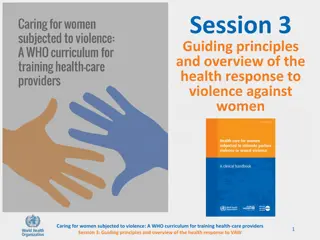
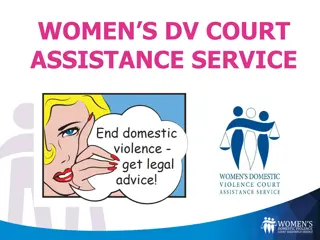




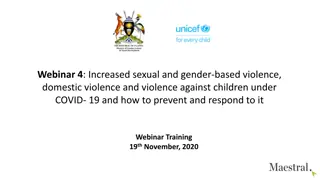
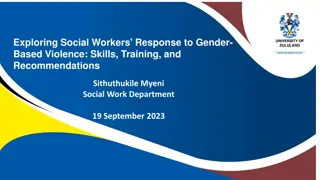


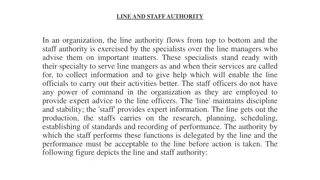






![Workplace Violence Prevention Plan in [District]: Definitions, Elements, and Implementation](/thumb/117038/workplace-violence-prevention-plan-in-district-definitions-elements-and-implementation.jpg)
